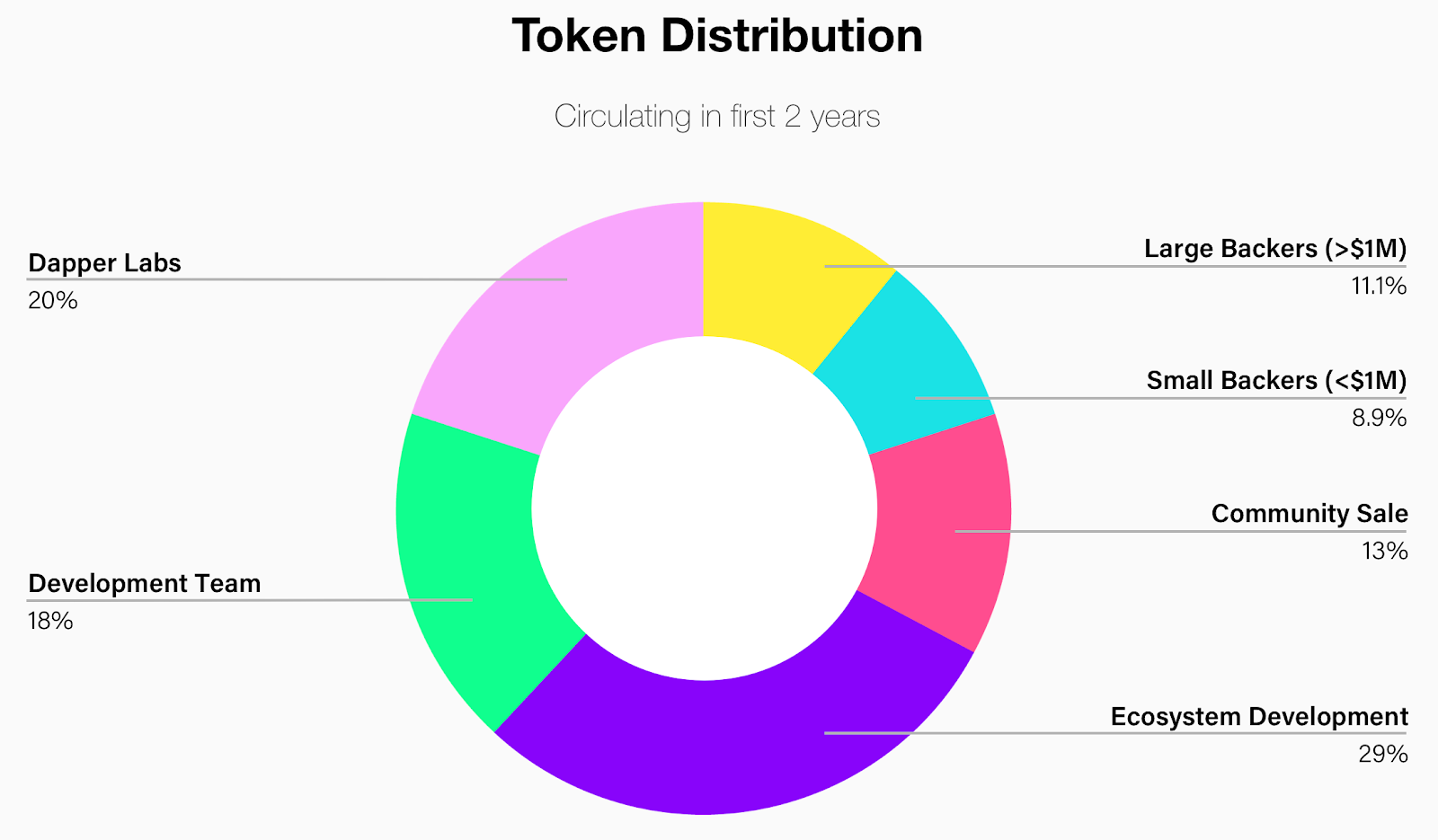บทความ
รู้จัก FLOW บล็อกเชนที่เป็นพาร์ตเนอร์ด้าน NFT กับ Meta

เมื่อประมาณกลางปี 2022 หลายคนน่าจะได้เห็นข่าวที่บริษัท Meta ประกาศพัฒนาระบบของสะสมดิจิทัลที่อยู่ในรูปแบบ NFT ให้กับแพลตฟอร์ม Facebook และ Instagram กันไปแล้ว ซึ่งบล็อกเชนที่ Meta เลือกใช้ก็คือ Flow นั่นเอง
แล้วทำไม Meta ถึงเลือก Flow เป็นบล็อกเชนสำหรับ NFT ของพวกเขากันล่ะ Bitkub Blog จะมาเล่าให้ทุกคนรู้จักกับ Flow ให้มากขึ้นในบทความนี้ครับ
Flow คืออะไร?
Flow คือบล็อกเชนถูกพัฒนาโดยบริษัท Dapper Labs ผู้พัฒนาเดียวกับ CryptoKitties เพื่อเป็นบล็อกเชนที่มุ่งเน้นการอำนวยความสะดวกให้นักพัฒนาสามารถสร้างแอปพลิเคชันหรือเกมที่ขับเคลื่อนโดยสินทรัพย์ดิจิทัลและ NFT ได้ง่ายขึ้น โดยเครือข่าย Flow เริ่มต้นทำงานครั้งแรกในปี 2020 และใช้ระบบแบ่งหน้าที่ให้กับโหนดในเครือข่าย (Multi-role) แทนที่การใช้ระบบ Sharding เพื่อขยายขนาดเครือข่าย
การที่ Flow เลือกใช้ระบบ Multi-role แทนระบบ Sharding นั่นก็เพราะพวกเขามองว่าระบบ Sharding มีความยุ่งยากมากกว่า และพวกเขาต้องการให้บล็อกเชนของพวกเขาเป็นมิตรกับนักพัฒนาให้มากที่สุด จึงเลือกใช้ระบบ Multi-role นั่นเอง
บล็อกเชน Flow มีเหรียญ FLOW หรือ Flow token เป็นเหรียญหลักที่ใช้สำหรับการมีส่วนร่วมบนบล็อกเชนของ Flow ไม่ว่าจะเป็นการวางค้ำประกัน (Stake) เพื่อทำหน้าที่ต่าง ๆ ในเครือข่าย หรือใช้เป็นสกุลเงินกลางในการแลกเปลี่ยนและใช้งานแอปพลิเคชันบนเครือข่าย
จุดเด่นของ Flow
Flow เป็นเครือข่ายที่คอลเลกชัน NFT อย่าง NBA Top Shot หรือ NFL All Day รวมถึงเกมบล็อกเชนอย่าง F1® Delta Time และ The Sandbox ถูกสร้างขึ้น ขณะที่ Dapper Labs ก็เป็นบริษัทที่ได้รับความไว้วางใจจากแบรนด์ดังระดับโลก เช่น Warner Music Group ที่ร่วมลงทุนเป็นมูลค่ากว่า 250 ล้านดอลลาร์ในปี 2021 หรือ Google Cloud ที่ร่วมเป็นพาร์ตเนอร์เพื่อช่วยให้บล็อกเชนของ Flow ขยายขนาดได้อย่างมีประสิทธิภาพยิ่งขึ้น
และจะไม่พูดถึงไม่ได้เลยก็คือการที่ Meta เลือกใช้บล็อกเชนของ Flow ในการพัฒนาโปรเจกต์ NFT สำหรับแพลตฟอร์ม Facebook และ Instagram ซึ่งเป็นข่าวที่ฮือฮามากเมื่อช่วงเดือนสิงหาคม 2022 ที่ผ่านมา นั่นจึงทำให้ Flow เป็นอีกบล็อกเชนที่โดดเด่นและมีการเติบโตที่น่าจับตามากที่สุดอีกเครือข่ายหนึ่ง
สำหรับจุดเด่นที่ทำให้ Flow ถูกเลือกโดยโปรเจกต์และแบรนด์ระดับโลกมากมาย มาจากคุณสมบัติหลัก 4 ข้อที่ระบุไว้บนเว็บไซต์หลักของ Flow ดังต่อไปนี้
1. รองรับผู้ใช้จำนวนมาก — Flow ถูกออกแบบให้สามารถขยายระบบให้รองรับจำนวนผู้ใช้ที่มากขึ้นได้แบบอัตโนมัติ ไม่ต้องมีการแบ่งหน่วยการประมวลผลข้อมูล (Sharding) จึงไม่กระทบต่อระบบฉันทามติ
2. สนับสนุน Smart Contract — Cadence คือภาษาโปรแกรมบนแพลตฟอร์ม Flow ที่ใช้ในการเขียน Smart Contract ซึ่งสามารถใช้งานได้ง่าย เหมาะกับในการสร้างแอปพลิเคชันต่าง ๆ บนบล็อกเชน
3. ระบบที่เอื้อต่อนักพัฒนา — Smart Contract ของ Flow สามารถปรับแต่งได้อย่างยืดหยุ่นตามความต้องการของนักพัฒนา และมาพร้อมกับเครื่องมือสำหรับการพัฒนามากมาย
4. เอาใจใส่ผู้ใช้ — Flow สามารถเปลี่ยนเงินเฟียตเป็นคริปโทเคอร์เรนซี เพื่อให้ผู้ใช้สามารถดำเนินธุรกรรมผ่านแพลตฟอร์มของ Flow ได้อย่างสะดวกรวดเร็ว
การทำงานของ FLOW
Flow ใช้ระบบฉันทามติ (Consensus Algorithm) แบบ Proof-of-Stake (PoS) ซึ่งถูกปรับปรุงมาจาก HotStuff ที่ถูกคิดค้นโดยนักวิจัยที่มหาวิทยาลัย Cornell
หากเทียบกับเครือข่ายบล็อกเชน PoS อื่น ๆ โหนด (Node) หรือผู้มีส่วนร่วมกับเครือข่ายต้องดาวน์โหลดข้อมูลทั้งหมดของบล็อกเชนถึงจะทำหน้าที่บนบล็อกเชนได้ แต่ถ้าเป็น Flow โหนดสามารถเลือกหน้าที่ของตัวเองได้ ซึ่งจะมีหน้าที่ให้เลือกทั้งหมด 4 ตำแหน่ง แต่ละตำแหน่งจะสัมพันธ์กับจำนวนเหรียญที่วางค้ำประกัน (Stake) และประสิทธิภาพของฮาร์ดแวร์ของผู้ใช้ ดังต่อไปนี้
1. Collection — ผู้รวบรวมและตรวจสอบความถูกต้องของธุรกรรมต่าง ๆ ก่อนส่งต่อไปยังตำแหน่งอื่น (ต้องวางค้ำประกันอย่างน้อย 250,000 FLOW ถึงจะมีสิทธิ์ทำหน้าที่นี้)
2. Consensus — ผู้สร้างบล็อกบนบล็อกเชนของ Flow และยังมีหน้าที่ตรวจสอบความถูกต้องของข้อมูลที่ถูกรวบรวมมาให้ (ต้องวางค้ำประกันอย่างน้อย 500,000 FLOW ถึงจะมีสิทธิ์ทำหน้าที่นี้)
3. Execution — ผู้รับรองข้อมูลธุรกรรมในขั้นตอนสุดท้ายและจัดเก็บข้อมูล โดยรับรองผ่านการคำนวน Output ของแต่ละบล็อก เพื่อการันตีว่าข้อมูลที่ได้รับมามีความถูกต้อง (ต้องวางค้ำประกันอย่างน้อย 1,250,000 FLOW ถึงจะมีสิทธิ์ทำหน้าที่นี้)
4. Verification — ผู้ยืนยันความถูกต้องของข้อมูลที่ได้รับมาจากผู้ใช้ระดับ Execution โดยตรวจสอบจากข้อมูลที่ได้ถูกบันทึกเอาไว้ในขั้นตอนก่อนหน้าและลงบันทึกรับรองความถูกต้อง
นอกจากประเภทข้างต้น ยังมี Access nodes ที่มีหน้าที่ส่งรายการธุรกรรมให้แก่โหนดในตำแหน่งอื่น ๆ ให้สอดคล้องกับหน้าที่และข้อมูลส่วนที่รับผิดชอบ โดยผู้ใช้ประเภทนี้จะถูกเลือกด้วยการตรวจสอบประวัติและความน่าเชื่อถือ ไม่ใช่จากการวางค้ำประกัน
เมื่อโหนดช่วยตรวจสอบรายการธุรกรรมบนบล็อกเชน เขาจะได้รับรางวัลเป็นเหรียญ FLOW ซึ่งจะได้รับตามประสิทธิภาพการทำงานและสัดส่วนเหรียญที่วางค้ำประกันไว้
ใครคือผู้สร้าง FLOW?

Flow ถูกสร้างขึ้นโดย Dapper Labs บริษัทเทคโนโลยีในประเทศแคนาดาที่ร่วมก่อตั้งขึ้นโดย Roham Gharegozlou และ Dieter Shirley ในตำแหน่ง CEO และ CTO ตามลำดับ โดยพวกเขามีผลงานอื่น ๆ อีกมากมาย เช่น CryptoKitties, NBA Top Shot และ Dapper Wallet ซึ่งล้วนแต่เป็นผลงานที่มีชื่อเสียงในวงการเกมบล็อกเชน
หน้าที่ของเหรียญ FLOW
FLOW หรือ Flow token คือเหรียญที่ใช้สำหรับการมีส่วนร่วมบนบล็อกเชนของ Flow ไม่ว่าจะเป็นการวาง FLOW เพื่อค้ำประกัน หรือใช้เป็นสกุลเงินกลางในการแลกเปลี่ยนสินทรัพย์บนเครือข่าย
FLOW ถูกสร้างขึ้นมาโดยไม่มีการกำหนดเพดานจำนวนเหรียญที่จะสามารถมีได้ทั้งหมด ในช่วงที่เครือข่ายเริ่มทำงาน Dapper Labs สร้างเหรียญ FLOW ออกมา 1.25 พันล้านเหรียญ และมีการกระจายโทเคนตามภาพด้านล่าง

20% แบ่งให้กับ Dapper Labs
18% แบ่งให้กับทีมพัฒนาของ Flow (Development Team)
29% ถูกเก็บไว้สำหรับการพัฒนาระบบนิเวศของ Flow (Ecosystem Development)
13% เปิดขายให้กับนักลงทุนทั่วไป (Community Sale)
20% แบ่งให้กับนักลงทุนกลุ่มแรก (Early Investors) โดยเป็นนักลงทุนรายใหญ่ที่ลงทุนมากกว่า 1 ล้านดอลลาร์ (Large Backers) และนักลงทุนรายย่อยที่ลงทุนน้อยกว่า 1 ล้านดอลลาร์ (Small Backers)
เนื่องจากผู้สร้างไม่ได้กำหนดเพดานจำนวนเหรียญสูงสุด ทำให้ Flow เป็นโทเคนที่สามารถเฟ้อได้ (Inflationery) อย่างไรก็ตาม มีความเป็นไปได้ที่อัตราการเฟ้อของ FLOW จะอยู่ที่ 0% หากมีธุรกรรมเกิดขึ้นมากพอ เนื่องจากอัตราเฟ้อจะสอดคล้องกับปริมาณธุรกรรมบนบล็อกเชน หากมีการทำธุรกรรมน้อย รายได้ของโหนดที่มาจากค่าธรรมเนียมก็จะน้อยลง ทำให้ FLOW ถูกผลิตออกมาเพิ่มขึ้น กลับกัน ถ้ามีปริมาณธุรกรรมสูง FLOW ก็จะถูกออกมาผลิตน้อยลงนั่นเอง
อ้างอิง Coinmarketcap, Flow docs, Flow, CoinList, Cornell University
_________________________________________
คำเตือน:
*คริปโทเคอร์เรนซีและโทเคนดิจิทัลมีความเสี่ยงสูง ท่านอาจสูญเสียเงินลงทุนได้ทั้งจํานวน โปรดศึกษาและลงทุนให้เหมาะสมกับระดับความเสี่ยงที่ยอมรับได้
**สินทรัพย์ดิจิทัลมีความเสี่ยง โปรดศึกษาและลงทุนให้เหมาะสมกับระดับความเสี่ยงที่ยอมรับได้
***ผลตอบแทนของสินทรัพย์ดิจิทัลในอดีตหรือผลการดําเนินงานในอดีต มิได้เป็นสิ่งยืนยันถึงผลตอบแทน ของสินทรัพย์ดิจิทัลหรือผลการดําเนินงานในอนาคต
_________________________________________
ติดตามบทความที่น่าสนใจได้ที่นี่:
อะไรคือหัวใจแห่ง Blockchain?
Smart Contract คืออะไร?
เกมบน Blockchain แตกต่างอย่างไร เล่นแล้วได้เงินจริงหรือ!?
_________________________________________
Get to know FLOW, the Blockchain that partners with Meta

In 2022, many of you might have seen the news that Meta announced that they will develop digital collectibles in the format of NFT for Facebook and Instagram, and the blockchain that Meta chose is Flow.
Why did Meta choose Flow for their NFT project? Bitkub Blog will introduce you to Flow in this article.
What is Flow?
Flow is a blockchain developed by Dapper Labs company, which is also the developer of CryptoKittes. Flow aims to facilitate the developers with the ability to create applications or games driven by digital assets and NFT easier. Flow network was first launched in 2020 and used the Multi-role system instead of Sharding to scale the network.
Flow chose the Multi-role system instead of the Sharding because they view Sharding as more complex, and Flow wants their blockchain to be as developer-friendly as possible, so they chose the Multi-role system.
Flow blockchain has FLOW or Flow token as their native cryptocurrency for participating on the blockchain, for example, staking in order to work in a specific role, or being the main currency for transactions and using the application on the network.
Flow’s Highlight
Flow is the network that NFT collections like NBA Top Shot or NFL All Day, or even game blockchains such as F1® Delta Time and The Sandbox built on. Moreover, Dapper Labs is trusted by the world's top brands, for example, Warner Music Group invested in Dapper Labs for more than 250 million dollars in 2021, and Google partnered with them to support Flow blockchain to scale more efficiently.
Another important thing that we have to talk about is that Meta chose Flow blockchain to develop their NFT project for Facebook and Instagram which became the talk of the town in August 2022. This makes Flow became another outstanding blockchain that has the potential for growth which we need to keep an eye on.
Flow was chosen by world-class projects and brands due to these 4 main properties that are listed on Flow’s website as follows.
1.Support a Large Number of Users: Flow was designed to be able to scale automatically to handle a larger amount of users without sharding, so it will not affect the consensus algorithm.
2.Support Smart Contract: Cadence is a programming language on Flow that is used to write the Smart Contract. It can be used easily which makes it fits for creating applications on the blockchain.
3.Facilitating Developers: Flow’s Smart Contract can be adjusted flexibly according to the developer's preference, and it also comes with many tools for developing.
4.Being user-friendly: Flow can exchange fiat to cryptocurrency allowing the users to make a transaction on Flow within a short period of time.
How does Flow work?
Flow uses Proof-of-Stake (PoS) consensus algorithm which was improved from HotStuff developed by researchers at Cornell University.
Compared with other blockchain networks that use PoS, the node or the participant of the network has to download all the information in order to work on the blockchain, but for Flow, a node can choose the role by themselves from the 4 roles available, and each role is related to the number of staking coins and the user’s hardware efficiency.
1.Collection: The person who gathers and checks the correctness of the transaction before sending it to another role (has to stake at least 250,000 FLOW to work in this role)
2.Concensus: The block creator on Flow blockchain, and this person also has to check the correctness of the gathered information (has to stake at least 500,000 FLOW to work in this role)
3.Execution: This position is responsible for verifying the transaction and storing the data. They will verify by calculating the output of each block to guarantee that the data received is correct (has to stake at least 1,250,000 FLOW to work in this role)
4.Verification: This role will assure that the data received from the execution level is correct by examing the data recorded in the previous process and certifying the correctness.
Other than the mentioned roles above, there are Access nodes, which are responsible for sending the transaction lists to nodes in other roles according to their roles and responsibility. This type of user will be chosen by background checking and reliability, not from a number of coins staked.
After nodes verify the transaction lists on the blockchain, they will receive FLOW coins as a reward according to the efficiency and amount of coin staking.
Who is the creator of FLOW?

Flow was created by Dapper Labs, the technology company in Canada, founded by Roham Gharegozlou and Dieter Shirley in the position of CEO and CTO respectively. Other famous works of Roham and Dieter in the blockchain field are CryptoKitties, NBA Top Shot, and Dapper Wallet.
FLOW’s Function
FLOW or Flow token is used in participating within the Flow blockchain ecosystem, not only for staking but also for transactions on the network.
FLOW was created without the maximum number of coins. During its first launch, Dapper Labs released 1.25 billion FLOW and distributed the token according to the diagram below.

20% allocated to Dapper Labs
18% allocated to the Flow development team
29% allocated to Flow’s ecosystem development
13% allocated to the investors (Community Sale)
20% allocated to Early Investors which are Large Backers or investor that has more than 1 million dollars in investing power and Small Backers or investor that has less than 1 million dollars in investing power.
It should be noted that FLOW is inflationary. However, it is possible that FLOW inflation rate will be at 0% if there are enough transactions because the inflation rate will be correlated with the number of transactions on the blockchain. If the number of transactions is small, the node’s revenue from the transaction fee will be less, and FLOW will be produced more. In contrast, if the number of transactions is high, FLOW will be produced less.
Reference: Coinmarketcap, Flow docs, Flow, CoinList, Cornell University
_________________________________________
Disclaimers:
- Cryptocurrency and digital tokens involve high risks; investors may lose all investment money and should study information carefully and make investments according to their own risk profile.
- Digital assets involve risks; investors should study information carefully and make investments according to their own risk profile.
- Returns/Past Performance does not guarantee future returns/performance.
ที่มา:
Medium